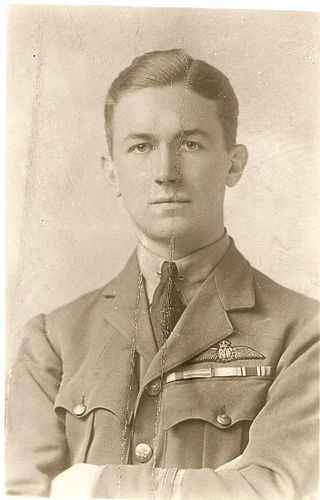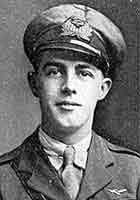Related Research Articles
Robert Alexander Little,, a World War I fighter pilot, is generally regarded as the most successful Australian flying ace, with an official tally of forty-seven victories. Born in Victoria, he travelled to England in 1915 and learned to fly at his own expense before joining the Royal Naval Air Service (RNAS). Posted to the Western Front in June 1916, he flew Sopwith Pups, Triplanes and Camels with No. 8 Squadron RNAS, achieving thirty-eight victories within a year and earning the Distinguished Service Order and Bar, the Distinguished Service Cross and Bar, and the French Croix de guerre. Rested in July 1917, he volunteered to return to the front in March 1918 and scored a further nine victories with No. 3 Squadron RNAS before he was killed in action on the night of 27 May, aged twenty-two.
Richard Pearman Minifie, was an Australian fighter pilot and flying ace of the First World War. Born in Victoria, he attended Melbourne Church of England Grammar School. Travelling to the United Kingdom, he enlisted in the Royal Naval Air Service in June 1916. Accepted for flight training, he completed his instruction in December and joined No. 1 (Naval) Squadron RNAS on the Western Front in January 1917, flying Sopwith Triplanes. He went on to score seventeen aerial victories on this type of machine throughout the year, becoming both the youngest Australian flying ace of the First World War and No. 1 (Naval) Squadron's highest-scoring ace on the Triplane. The unit re-equipped with the Sopwith Camel late in 1917, with Minifie going on to achieve a further four victories on the aircraft, raising his final tally to a score of twenty-one aircraft shot down.
Captain William Lancelot Jordan DSC & Bar, DFC was a South African World War I flying ace credited with 39 victories.
Captain William Melville Alexander was a Canadian First World War flying ace, officially credited with 22 aerial victories.

Major Charles Dawson Booker was an English World War I fighter ace credited with 29 victories. He was promoted to high rank while relatively young as a result of his gallantry and unswerving dedication to his country.
Leonard Henry Rochford, was a British flying ace of the First World War, credited with 29 aerial victories. He returned to military service in the Royal Air Force during the Second World War.
Wing Commander Robert John Orton Compston DSC & 2 Bars DFC was an English fighter pilot credited with 25 victories during World War I. He was one of only seven airman in this war who won three awards of the Distinguished Service Cross.
Group Captain Harold Alfred Whistler, was an English fighter pilot and flying ace in the First World War.
Wing Commander (rank) Noel Keeble was a British flying ace of the First World War, credited with six aerial victories.
Captain Thomas Sydney Sharpe was a British World War I flying ace credited with six aerial victories.

Captain Albert James Enstone was a British World War I flying ace. Various sources credit him with differing air victory scores. In one text, he is credited with 13 confirmed aerial victories and driving down 11 other German aircraft, including three Gotha bombers. Another source claims 15 confirmed aerial victories; ten were destroyed, and five were driven down out of control. He is known to have attacked two Gotha bombers. Regardless of his actual victory totals, records show that Enstone served his country valiantly.
Lieutenant Gavin Lynedoch Graham DFC, LdH, CdG was a South African World War I flying ace credited with thirteen confirmed aerial victories.
Captain John Ellis Langford Hunter was a British World War I flying ace credited with 13 confirmed aerial victories.
Flight Commander Guy William Price was an Irish Royal Naval Air Service flying ace during World War I, having 12 confirmed aerial victories. He was awarded the Distinguished Service Cross twice within a 22-day period.

Flight Sub-Lieutenant Harold Day was a Welsh World War I flying ace credited with 11 confirmed aerial victories.

Captain Reginald Rhys Soar was a British flying ace during World War I. He was credited with 12 official aerial victories won while serving in the Dardanelles and along the English Channel.
Captain Herbert Andrew Patey was an English World War I flying ace credited with 11 aerial victories.
Major Thomas Francis Netterville Gerrard was a British World War I flying ace credited with ten aerial victories. He died following a post-war equestrian accident.
Captain Ronald Roscoe Thornely was an English World War I flying ace. He was credited with nine aerial victories while flying for the Royal Naval Air Service.
Flight Lieutenant Desmond Fitzgerald Fitzgibbon was a British flying ace who served in the Royal Naval Air Service during World War I, and was credited with eight aerial victories. He returned to serve in the RAF for a few years in the early 1920s, and again during World War II.
References
- 1 2 3 4 5 6 "Harold Thomas Mellings". The Aerodrome. 2015. Retrieved 12 June 2015.
- ↑ "Aviators' Certificates". Flight . VII (360): 894. 19 November 1915. Retrieved 12 June 2015.
- ↑ "No. 29694". The London Gazette . 4 August 1916. p. 7675.
- ↑ "No. 30156". The London Gazette. 29 June 1917. p. 6415.
- ↑ Franks (2004), p.60.
- ↑ "Casualty Details: Mellings, Harold Thomas". Commonwealth War Graves Commission . 2015. Retrieved 12 June 2015.
- ↑ "No. 30147". The London Gazette (Supplement). 22 June 1917. p. 6256.
- ↑ "No. 30437". The London Gazette (Supplement). 18 December 1917. pp. 13318–13319.
- ↑ "No. 30913". The London Gazette (Supplement). 20 September 1918. p. 11253.
- ↑ "No. 30913". The London Gazette (Supplement). 20 September 1918. p. 11259.
- Bibliography
- Franks, Norman (2004). Sopwith Triplane Aces of World War I. London, UK: Osprey Publishing. ISBN 978-1-84176-728-4.
- Franks, Norman (2003). Sopwith Camel Aces of World War I. London, UK: Osprey Publishing. ISBN 978-1-84176-534-1.